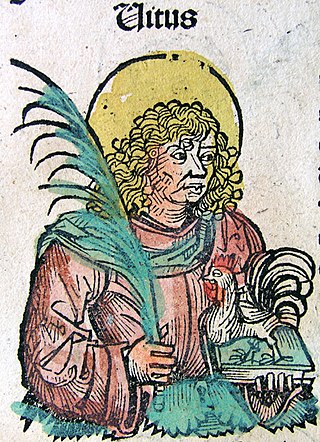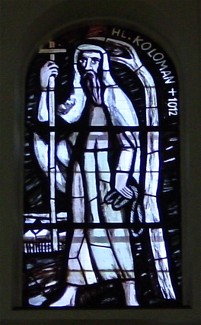Related Research Articles

Columbanus was an Irish missionary notable for founding a number of monasteries after 590 in the Frankish and Lombard kingdoms, most notably Luxeuil Abbey in present-day France and Bobbio Abbey in present-day Italy.

Vitus, whose name is sometimes rendered Guy or Guido, was a Christian martyr from Sicily. His surviving hagiography is pure legend. The dates of his actual life are unknown. He has for long been tied to the Sicilian martyrs Modestus and Crescentia but in the earliest sources it is clear that these were originally different traditions that later became combined. The figures of Modestus and Crescentia are probably fictitious.

The American teal or green-winged teal is a common and widespread duck that breeds in the northern areas of North America except on the Aleutian Islands. It was considered conspecific with the Eurasian teal for some time, but has since been split into its own species. The American Ornithological Society continues to debate this determination; however, nearly all other authorities consider it distinct based on behavioral, morphological, and molecular evidence. The scientific name is from Latin Anas, "duck" and carolinensis, "of Carolina".

The blue-winged teal is a species of bird in the duck, goose, and swan family Anatidae. One of the smaller members of the dabbling duck group, it occurs in North America, where it breeds from southern Alaska to Nova Scotia, and south to northern Texas. It winters along the Pacific and Atlantic coasts and south into the Caribbean islands and Central America.

Neot was an English monk. Born in the first half of the ninth century, he lived as a monk at Glastonbury Abbey. He preferred to perform his religious devotions privately, and he later went to live an isolated life in Cornwall, near the village now called St Neot. His wisdom and religious dedication earned him admiration from the monks. He visited the Pope in Rome, who instructed him to found a monastery in Cornwall.

The cotton pygmy goose or cotton teal is a small perching duck which breeds in Asia, Southeast Asia extending south and east to Queensland where they are sometimes called white-quilled pygmy goose. They are among the smallest waterfowl in the world and are found in small to large waterbodies with good aquatic vegetation. They are usually seen in pairs or larger groups of pairs, roosting and nesting on trees near water. They are strong fliers and are known to disperse widely, especially in winter. Their breeding season coincides with the rains.

Kilmacduagh Monastery is a ruined abbey near the town of Gort in County Galway, Ireland. It was the birthplace of the Diocese of Kilmacduagh. It was reportedly founded by Saint Colman, son of Duagh in the 7th century, on land given him by his cousin King Guaire Aidne mac Colmáin of Connacht.
Saint Fillan, Filan, Phillan, Fáelán or Faolán is the name of an eighth century monk from Munster, who having studied at Taghmon Abbey, traveled to Scotland and settled at Strath Fillan.

Saint Kevin is an Irish saint, known as the founder and first abbot of Glendalough in County Wicklow, Ireland. His feast day is 3 June.

Gerald of Mayo is a saint of the Roman Catholic Church and Eastern Orthodox Church. Born in Northumbria, the son of an Anglo-Saxon king, he was one of the English monks at Lindisfarne who accompanied Colmán of Lindisfarne to Iona and then to Ireland. This occurred after the Synod of Whitby 664AD which decided against the Irish method of calculating the date for Easter. Colman was an ardent supporter of the Irish traditions; after the synod decided to adopt the Roman computation.

Kilian, also spelled Cillian or Killian, was an Irish missionary bishop and the Apostle of Franconia, where he began his labours in the latter half of the 7th century. His feast day is 8 July.

Finnian of Movilla was an Irish Christian missionary. His feast day is 10 September.

Saint Colman mac Duagh was born at Corker, Kiltartan, County Galway, Ireland, the son of the Irish chieftain Duac. He initially lived as a recluse, living in prayer and prolonged fastings, first on Inismore, then in a cave at the Burren in County Clare. With his relative, King Guaire Aidne mac Colmáin of Connacht he founded the monastery of Kilmacduagh,, and governed it as abbot-bishop.

Saint Moluag was a Scottish missionary, and a contemporary of Saint Columba, who evangelized the Picts of Scotland in the sixth century. Saint Moluag was the patron saint of Argyll as evidenced by a charter in 1544, from the Earl of Argyll, which states "in honour of God Omnipotent, the blessed Virgin, and Saint Moloc, our patron". The House of Lorne became the kings of Dalriada and eventually united with the Picts to become the kings of Scots.

Colmán of Cloyne, also Colmán mac Léníne, was a monk, founder and patron of Cluain Uama, now Cloyne, County Cork, Ireland, and one of the earliest known Irish poets to write in the vernacular.

The South Georgia pintail, also misleadingly known as the South Georgian teal, is the nominate subspecies of the yellow-billed pintail, a duck in the dabbling duck subfamily Anatinae. It is endemic to the large (3,756 km2) subantarctic island of South Georgia and its accompanying archipelago, and is a vagrant to the South Sandwich Islands. It was among the birds noted by James Cook in January 1775, on the occasion of the first recorded landing on South Georgia, and was formerly considered a full species.

Coloman of Stockerau was an Irish saint. While on pilgrimage to the Holy Land, he was mistaken for a spy and hanged near Vienna.

Saint Féchín or Féichín, also known as Mo-Ecca, was a 7th-century Irish saint, chiefly remembered as the founder of the monastery at Fore (Fobar), County Westmeath.
Events from the 7th century in Ireland.
References
- ↑ Smith, William and Wace, Henry. "Colman",37, A Dictionary of Christian Biography, Literature, Sects and Doctrines, A-D, Little, Brown, 1877
- ↑ Fahey, Jerome. The History and Antiquities of the Diocese of Kilmacduagh, M. H. Gill & son, 1893
- ↑ Grattan-Flood, William. "St. Colman." The Catholic Encyclopedia. Vol. 4. New York: Robert Appleton Company, 1908. 29 Mar. 2015
- 1 2 3 Joyce, Patrick Weston, "St. Colman's Ducks", The Wonders of Ireland, 1911
- ↑ "St Colman's Teals, in Gerald of Wales, Topography of Ireland". British Library. Retrieved 12 February 2020.